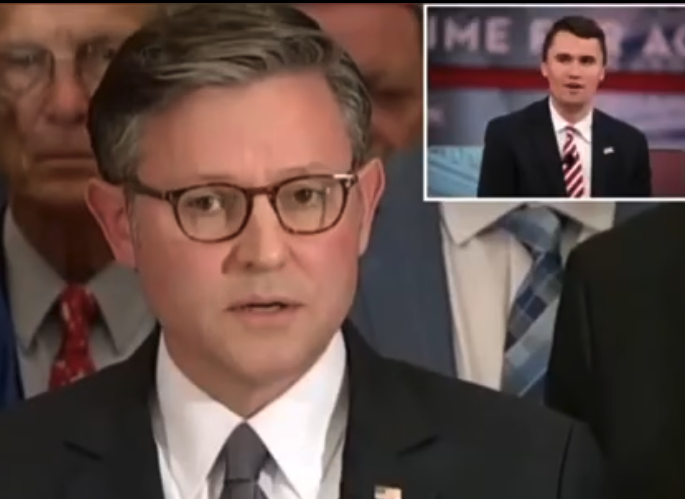
Trump and GOP Plan Historic Pre-Midterm Convention Amid Republican Voter Surge
In a move that could redefine the midterm election landscape, House Speaker Mike Johnson has publicly endorsed President Donald Trump’s proposal
to hold a presidential-style Republican National Convention ahead of the 2026 midterms. Trump described the idea as “something that has never been done before,” signaling a bold departure from traditional campaign strategies and reflecting Republican confidence in sustaining political momentum.
The proposal emerged during a phone call between Trump and Johnson just minutes before the Speaker appeared in Detroit for a scheduled event. Johnson recounted that Trump opened the conversation with characteristic energy: “Mike, I’ve got a great idea.” Johnson responded without hesitation: “Mr. President, let’s go.”
For Johnson, the midterm convention represents a strategic opportunity to rally Republican voters, showcase party accomplishments, and translate post-2024 gains into congressional victories. “It would be a great rallying point right before the midterm election,” Johnson said, emphasizing the timing as key to maintaining momentum.
Breaking With Tradition
Historically, presidential nominating conventions have occurred only in presidential election years, serving primarily to formalize party nominations. Trump’s proposal would upend that tradition, transforming the typically lower-profile midterm cycle into a
high-energy, national political spectacle.
Planning such an event involves complex logistics: selecting a politically symbolic and secure location, accommodating tens of thousands of attendees, coordinating extensive security, and executing months of advance preparation. Both Trump and Johnson appear undeterred, citing strong party enthusiasm and organizational readiness. Johnson predicted the GOP is “poised to perform well in next year’s midterms,” pointing to Republican victories across multiple fronts in 2024.
Trump Frames the GOP as Ascendant
Trump highlighted the party’s current strength in a statement on Truth Social, portraying Republicans as thriving both politically and financially. “We are doing really well,” he wrote, emphasizing fundraising successes and the party’s role in “fixing all of the Country Destroying mistakes made by the Biden Administration.” Trump positioned the Republican Party as the driving force behind national recovery, portraying the upcoming convention as a celebration of accomplishments and a
moment to energize supporters ahead of competitive midterms.
Johnson echoed the enthusiasm in a public post: “YES, Mr. President! Let’s go!!!!” accompanied by American flag emojis, signaling close alignment between the White House and congressional Republican leadership. This unity is central to the party’s strategy in defending congressional majorities.
Data Behind Republican Confidence
Republican optimism is bolstered by recent voter registration trends. Analysis from The New York Times, based on data from L2, shows that for the first time since 2018, more new voters registered as Republicans than Democrats nationwide. Between 2020 and 2024, Republicans gained roughly 2.4 million new registrants while Democrats lost about 2.1 million, a
net swing of 4.5 million voters.
The trend extends even into traditionally blue states, including California, suggesting a nationwide shift rather than isolated changes in battleground areas. Michael Pruser, director of data science at
Decision Desk HQ, described the shift as “relentless, sustained, and potentially enduring,” signaling a structural challenge for the Democratic Party.
Swing states critical to midterm outcomes—North Carolina, Pennsylvania, Arizona, and Nevada
—also show Republican advantages in new voter registrations, offering the GOP a tangible organizational edge ahead of 2026.
Expanding the Republican Coalition
The surge in registrations reflects Trump’s ability to
expand the Republican base beyond traditional constituencies. Working-class voters, Latino communities, and young men have increasingly aligned with GOP messaging, defying assumptions about demographic trends favoring Democrats. This expansion of the coalition strengthens the party’s grassroots infrastructure, with volunteers actively engaged in registration drives, canvassing, and organizing, providing lasting advantages beyond individual elections.
Convention as Rally and Strategy
Against this backdrop, Trump’s proposed midterm convention serves multiple purposes: celebrating Republican achievements, rallying the party faithful, demonstrating organizational unity, and shaping the national narrative ahead of critical elections. The unprecedented timing is expected to generate significant media attention, amplifying Republican messaging across the country.
The event would also provide Trump with a platform to influence down-ballot races, creating a unified message for Republican candidates in both chambers. Its spectacle is designed not only to energize supporters but to project strength and confidence to voters nationwide.
Looking Ahead
Trump and Johnson are moving forward with planning, focusing on selecting a location and finalizing dates to transform the proposal into reality. With voter registration gains, fundraising advantages, and a broadened coalition, Republicans approach 2026 with ambitious goals. The midterms, traditionally a referendum on the party out of power, could instead become a
stage for Republican momentum, capped by a historic pre-midterm convention unlike anything seen in modern American politics.
This strategy underscores the GOP’s confidence in reshaping the midterm cycle and solidifying Trump’s dominance within the party, while Democrats face mounting challenges to maintain their foothold in Congress.